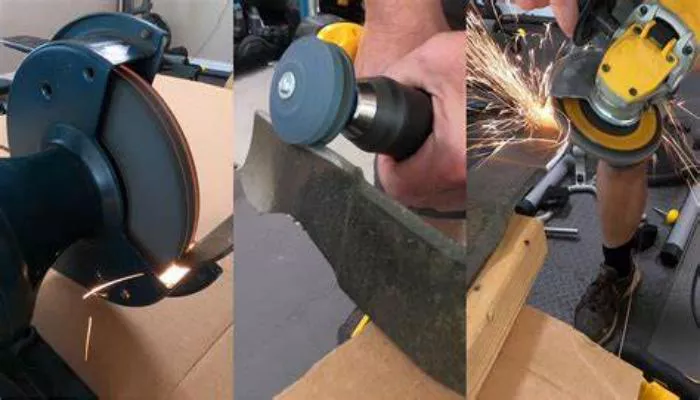Sharpening lawn mower blades is an essential maintenance task that every homeowner should master. A sharp blade ensures a clean, precise cut, which promotes healthier grass and prevents disease. Using an angle grinder is one of the fastest and most effective ways to sharpen blades, providing professional results with minimal effort. This guide will explain the process in detail, combining expert knowledge with practical steps to help you achieve a razor-sharp edge. Whether you’re a beginner or an experienced DIYer, these techniques will keep your mower performing at its best.
Why Sharpening Lawn Mower Blades Matters?
A dull lawn mower blade tears grass instead of cutting it cleanly. Torn grass turns brown and becomes more susceptible to disease. A sharp blade reduces stress on the mower’s engine and improves fuel efficiency. Regular sharpening extends the life of your mower and keeps your lawn looking its best.
An angle grinder is a powerful tool for sharpening. It removes metal quickly and evenly. However, improper use can damage the blade or create an unsafe edge. Following the correct steps ensures a professional result.
Safety Precautions Before Starting
Working with an angle grinder requires caution. Always wear safety gear to protect yourself.
Safety Gear
Wear gloves, safety glasses, and ear protection. Angle grinders produce sparks and loud noise. Gloves prevent cuts, and safety glasses shield your eyes from debris.
Secure the Blade
Remove the blade from the mower before sharpening. Clamp it securely in a vise to prevent movement. A loose blade can cause accidents.
Check for Damage
Inspect the blade for cracks or excessive wear. A damaged blade should be replaced rather than sharpened.
Disconnect Power
If using an electric angle grinder, ensure it is unplugged when attaching or adjusting the grinding wheel.
Tools and Materials Needed
Before starting, gather the necessary tools and materials.
Angle Grinder: A 4.5-inch angle grinder is ideal for lawn mower blades. It provides enough power without being too heavy.
Grinding Wheel: Use a flap disc or a dedicated grinding wheel for metal. A coarse grit (around 40-60) works best for initial sharpening.
Vise or Clamps: Secure the blade firmly to prevent slipping.
Protractor or Angle Guide: Helps maintain the correct sharpening angle.
File or Honing Stone: For final edge refinement.
Balancing Tool: Ensures the blade is balanced after sharpening.
Removing the Lawn Mower Blade
The first step is removing the blade from the mower.
Disconnect the Spark Plug: Prevents accidental engine starts.
Tip the Mower Safely: Turn the mower on its side with the air filter facing up. This prevents oil leaks.
Mark the Blade Orientation: Use chalk or a marker to note which side faces the ground. Reinstalling it backward affects cutting performance.
Loosen the Bolt: Use a wrench or socket to remove the blade bolt. Some bolts may require penetrating oil if stuck.
Setting Up the Angle Grinder
Proper setup ensures efficient and safe sharpening.
Attach the Grinding Wheel: Secure the wheel tightly and check for wobbles.
Adjust the Guard: Position the guard to deflect sparks away from you.
Set the Grinder Speed: Use a medium speed setting to avoid overheating the blade.
Sharpening the Lawn Mower Blade
Follow these steps for a precise and even edge.
Secure the Blade: Clamp it in a vise with the cutting edge facing up.
Match the Original Angle: Most blades have a 30 to 45-degree angle. Use an angle guide if unsure.
Grind Along the Edge: Move the grinder along the blade in smooth, even strokes. Avoid pressing too hard to prevent overheating.
Maintain Consistent Pressure: Uneven grinding creates an unbalanced edge.
Cool the Blade: Dip it in water occasionally to prevent overheating.
Repeat for the Other Side: Sharpen both edges equally to maintain balance.
Finishing the Edge
A smooth edge improves cutting performance.
Use a File or Honing Stone: Remove burrs and refine the edge.
Check for Sharpness: The blade should easily cut through paper.
Balancing the Blade
An unbalanced blade causes vibration and damages the mower.
Use a Balancing Tool: Hang the blade on a nail or use a dedicated balancer.
Check Both Ends: The blade should sit level. If one side dips, grind a small amount off the heavier end.
Reinstalling the Blade
Proper reinstallation ensures safe operation.
Align the Blade Correctly: Follow the orientation marks made earlier.
Tighten the Bolt Securely: Use a torque wrench if possible to avoid over-tightening.
Reconnect the Spark Plug: Restore power to the mower.
Testing the Mower
After sharpening, test the mower’s performance.
Start the Engine: Listen for unusual vibrations.
Mow a Small Area: Check for clean, even cuts.
Maintaining Sharp Blades
Regular maintenance keeps blades sharp longer.
Clean After Use: Remove grass clippings and debris.
Inspect Frequently: Check for nicks or dullness.
Sharpen as Needed: Most blades need sharpening every 20-25 hours of use.
Common Mistakes to Avoid
Avoid these errors for the best results.
Overheating the Blade: Weakens the metal.
Ignoring Balance: Causes vibration and engine strain.
Skipping Safety Gear: Increases injury risk.
Conclusion
Sharpening lawn mower blades with an angle grinder is efficient and effective. Following the correct steps ensures a sharp, balanced blade for a healthy lawn. Regular maintenance extends the life of your mower and improves cutting performance. Always prioritize safety and precision for the best results.
By mastering this skill, you save money on professional sharpening and keep your lawn in top condition. A well-maintained mower is the key to a beautiful, lush yard.
Related topics:
- HOW TO SHARPEN LAWN MOWER BLADES WITH A BENCH GRINDER
- HOW TO MAKE A LAWN MOWER BLADE SHARPENING JIG?
- HOW TO SHARPEN MANUAL LAWN MOWER BLADES WITH A FILE

